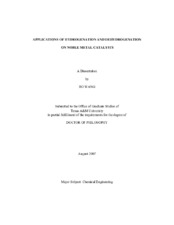| dc.description.abstract | Hydrogenation and dehydrogenation on Pd- and Pt- catalysts are encountered in
many industrial hydrocarbon processes. The present work considers the development of
catalysts and their kinetic modeling along a general and rigorous approach. The first part
deals with the kinetics of selective hydrogenation, more particularly of the C3 cut of a
thermal cracking unit for olefins production. The kinetics of the gas phase selective
hydrogenation of methyl-acetylene (MA) and propadiene (PD) over a Pd/γ-alumina
catalyst were investigated in a fixed bed tubular reactor at temperatures 60 - 80 oC and a
pressure of 20 bara. Hougen-Watson type kinetic equations were derived. The formation
of higher oligomers slowly deactivated the catalyst. The effect of the deactivating agent
on the rates of the main reactions as well as on the deactivating agent formation itself
was expressed in terms of a deactivation function multiplying the corresponding rates at
zero deactivation. Then, the kinetic model was plugged into the reactor model to simulate an industrial adiabatic reactor. In the second part the production of hydrogen
from hydrocarbons was investigated. In both cyclohexane and decalin dehydrogenations,
conversions higher than 98% could be obtained over Pt/γ-alumina catalyst at temperature
of 320 and 340 oC, respectively, with no apparent deactivation for 30 h and with co-feed
of H2 in the feed. Except for H2 and trace amounts of side cracking products, less than
0.01%, benzene was the only dehydrogenated product in cyclohexane dehydrogenation.
In the case of decalin dehydrogenation, partially dehydrogenated product, tetralin, was
also formed with selectivity lower than 5%, depending on operating conditions. A
rigorous Hougen-Watson type kinetic model was derived, which accounted for both the
dehydrogenation of cis- and trans- decalin in the feed and also the isomerization of the
two isomers. Jet A is the logic fuel in the battlefields. The dehydrogenation of Jet A can
produce H2 for military fuel cell application. Although the H2 production is lower than
that of steam/autothermal reforming, it eliminates the needs of high temperature and
product separation operation. | en |


